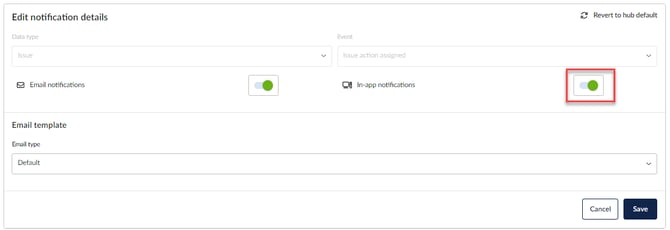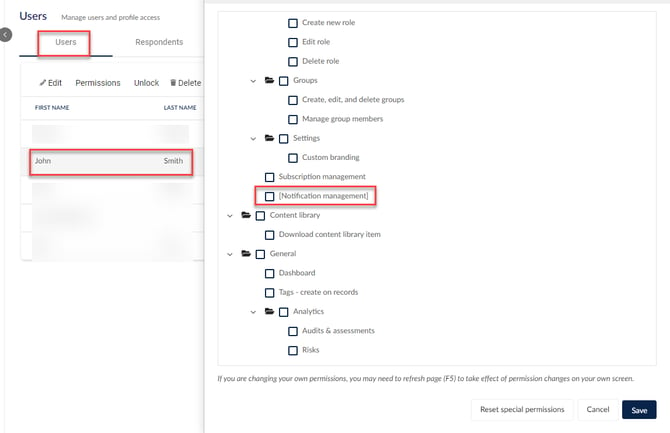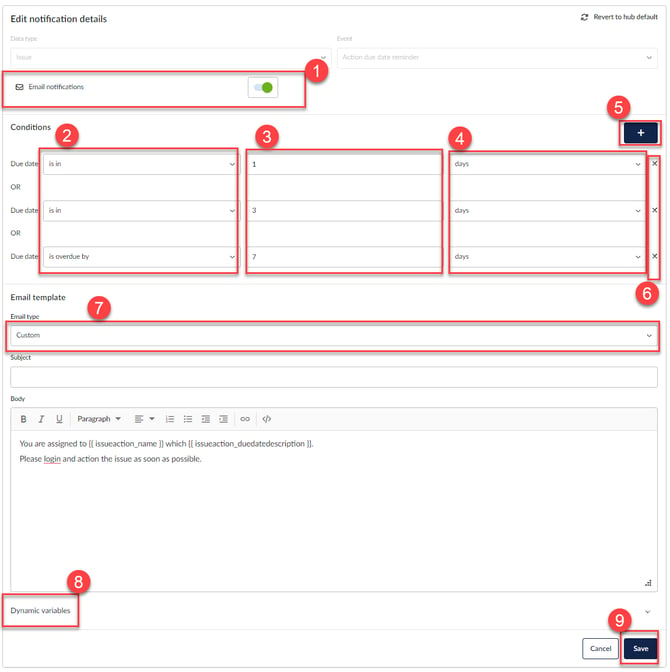Custom Notifications
Discover how to personalize your notifications to receive customized updates for different modules in 6clicks.
Table of contents:
- Configure Custom Notifications
- Permissions
- Configuring Notifications
- In-app Notifications
- Conditions
- Hub and Spoke support
Log in to your 6clicks environment and go to Administration > Notifications.
If you do not see Notifications in your environment please contact the 6clicks support.
Permissions
The Notification feature is automatically enabled by default for all Administrator users and can also be assigned to individual users as needed in the Permissions tab. Go to Administration>Users and click on the user you wish to assign this permission to. Make sure the Notification management option is ticked and click Save.
Configuring notifications
The below image shows an example of customising the "Assessment Submitted" event.
- To customize notifications, start by clicking on the pencil icon.
- On the right side, you can make any changes necessary. Enable Email notifications by moving the toggle to the right.
- Choose whether you want to make your own email template or use the default one. In this case, we are making our own and have selected Custom.
- Enter the Subject of your custom email.
- Enter a general email in the body. Note that a header with either the 6clicks logo or your orgnaization's custom-branded logo, as well as a footer with an unsubscribe link, will be added to the email.
- You can use dynamic data in both the subject and email body. Click on Dynamic variables to see the list of variables available. Make sure to include the "handlebars" {{ }} around the variable name, and to ensure the variables are entered exactly as specified.
- For finer control, click on Souce Code in the top right of the editor and you can edit the raw HTML code

- Once you are done customizing your notification, click on Save.
When an assessment is submitted you will receive an email containing the subject and the body as specified.
In-app Notifications
When available, some events offer the option to enable or disable in-app notifications, as well as emails.
Conditions
Some event types allow for conditional logic to be specified. In particular, this can be used to specify reminder cadences. Here we will use Issue - Action due date reminder as an example.
First, edit the Issue - Action due date reminder event.
The image below shows the steps for configuring when the issue action reminder should be sent.
(1) - Enable Email notifications by moving the toggle to the right.
(2) - You can change between either an upcoming due date or a past due date, by selecting either is in or is overdue by.
(3) and (4) - Select the number of days, weeks or months.
(5) - To add more conditions to your issue actions, click the plus sign.
(6) - To remove any fields, click the X.
(7) - In the Email Template section, select Custom under Email Type and enter your desired email subject and email body.
(8) - You can choose dynamic data from the list of Dynamic variables. For example, enter You have one issue action due from {{tenant_name}} .
(9) - Once you’re happy with your changes, click Save .
Note that the email will be sent when any of the specified conditions are met. For example, in the image above, the email will be sent 3 days prior to the due date, 1 day prior, and 7 day after.
If you need to send different notifications depending on the conditions (such as sending different email content before and after the due date has passed), you can create additional notifications configurations for the same event by clicking Create notification.
Hub and Spoke support
By default, the notifications settings established in the hub account will also apply to all spokes. If desired, these settings can then be overridden by the Spoke account.
To override Hub defaults for a certain spoke, log in to the spoke account as an advisor or administrator, go to Administration>Notifications, and make changes as required.
In the image below, a badge (1) indicates that the notification settings are inherited from the hub. When no badge is shown (2), the notification settings are configured by the spoke. You can delete the spoke settings and revert to the Hub settings by clicking the trash can icon.Note: To ensure consistent email delivery of 6clicks application notifications, we recommend whitelisting the domain *.6clicks.io This will automatically cover all associated subdomains we may use, ensuring that all email notifications are successfully delivered to the recipients and are not automatically unsubscribed should the sending domain change.






